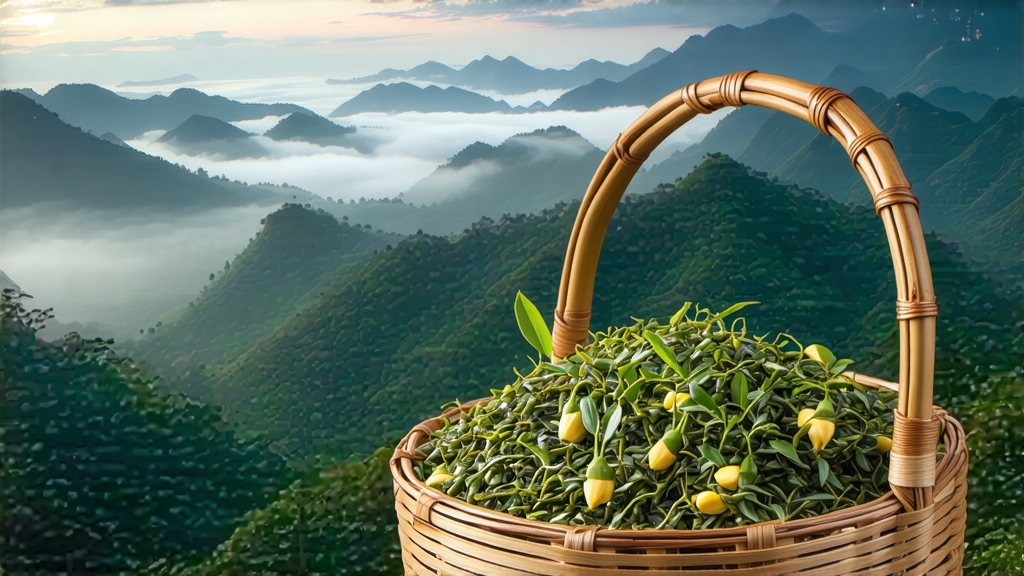
Tucked away above the perpetual cloud belt of Sichuan’s Mengding Mountain, a tea has been whispering its golden secret for more than twelve centuries. International drinkers rightly celebrate Longjing, Da Hong Pao and Pu-erh, yet few have heard the hushed name Mengding Huangya—literally “the yellow sprout of Mengding.” It is the oldest recorded yellow tea, the first tribute tea of China, and still the most elusive. To understand it is to step into a cool mountain morning where Taoist hermits once brewed immortality, where Tang-dynasty emperors sent horse-mounted couriers for the earliest buds, and where a single night of controlled “sealed yellowing” can turn jade-green leaves into liquid topaz.
History: from imperial altar to forgotten grove
Mengding Mountain rises 1 456 m at the western edge of the Sichuan basin. Its peaks trap moist monsoon clouds, creating 200 foggy days a year and an almost permanent drizzle that locals call “meng yu,” or dream rain. In 53 BCE, the Taoist cultivar Gan Lu planted the first garden here; by 742 CE the An Lushan court registered Mengding as the first official tribute tea, demanding that monks deliver “one bud, one leaf, picked before Qingming” to Chang’an within seven days. Song emperor Huizong, himself a tea connoisseur, elevated the leaf to “first among the eighteen imperial teas,” and Ming Taizu exempted the monastery from taxes in exchange for 500 jin of the earliest buds. Yet when green-tea fixation techniques spread in the Qing, the laborious yellowing process was gradually abandoned. By 1959 only three old artisans could still recall the full recipe; the gardens were replanted with fast-growing shrub varieties. A state-led restoration project in 1978 rescued wild ancient trees hidden in a ravine called Wuyun Temple, and today fewer than 8 000 kg of authentic Mengding Huangya reach the market each year.
Micro-terroir: why the mountain tastes of orchid and stone
The mountain’s soil is a crumbly purple sandstone rich in selenium and zinc, weathered from Jurassic strata. Night temperatures drop 10 °C within two hours, forcing the tea bush to convert starch into soluble sugars and amino acids—especially L-theanine, which reaches 4.2 %, twice the level of平地 green teas. The omnipresent mist filters ultraviolet light, slowing photosynthesis and tightening cell walls; the result is a bud so tender that it can be kneaded between finger and thumb without breaking, yet so fragrant that pluckers can smell orchid notes while the leaf is still on the tree. Only the clones Camellia sinensis var. sinensis cv. Mengding #9 and the ancient seed-grown “xiao ye zhong” are accepted for authentic Huangya; both have tiny, down-curved buds shaped like a sparrow’s tongue, covered in microscopic hairs that refract light into a pale golden halo.
Craft: the 48-hour breath that turns green to gold
Unlike green tea, which is immediately pan-fired to lock in verdant chlorophyll, Mengding Huangya must be coaxed into a slow oxidation nicknamed “men huang”—sealed yellowing. The process unfolds in three stages across two nights and demands a relative humidity window of 78–82 %; if the mountain air is too dry the leaf browns, too moist and it sours.
-
Kill-green with living charcoal. Buds are tossed for 3–4 minutes on a wok heated to 140 °C by Chinese chestnut wood charcoal. The goal is not full de-enzymation but a partial denaturation that leaves 15 % polyphenol oxidase alive—this residual enzyme is the painter that will later splash yellow across the leaf.
-
First wrapping. The barely warm leaves are piled 3 cm thick on a sheet of yellow bamboo paper, wrapped into a loose parcel, and slid into a hemp-lined cedar box. For the next 6 hours the bundle is turned every 30 minutes; temperature is monitored by touch—when the paper feels like a baby’s forehead (37 °C) it is unwrapped to breathe. During this phase chlorophyll begins to hydrolyze, releasing phaeophorbide that tints the leaf jade-yellow.
-
Second firing & re-wrapping. A gentler 80 °C roast for two minutes drives off